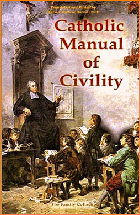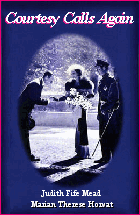Manners, Customs, Clothing
 |
 |
 |
 |
 |
 |
 |
Braided Hair & Piercings for Women
A reader recently queried us about how to interpret Timothy’s exhortation on modesty to women. In like manner women also in decent apparel: adorning themselves with modesty and sobriety, not with plaited hair, or gold, or pearls, or costly attire. But as it becometh women professing godliness, with good works. (1 Tim 2:9)
Her question: “I am wondering if you would address how modesty relates to hair and jewelry. Is it wrong to braid one’s hair or wear jewelry? What about ear and nose piercings?”
Dr. Horvat & Miss Lozowski respond:
We commend you for taking seriously the instructions of St. Paul to the early Christians.
/C089_Bra.jpg) In order to understand St. Paul’s exhortations, it is important to first understand the historical fashion to which he was referring. When St. Paul refers to braids, he is thinking of the elaborate and extravagant braided hairstyles that were becoming popular among the Roman women.
In order to understand St. Paul’s exhortations, it is important to first understand the historical fashion to which he was referring. When St. Paul refers to braids, he is thinking of the elaborate and extravagant braided hairstyles that were becoming popular among the Roman women.
This article – although written by a Protestant – explains well the historical context of the adornments of Roman women at the time of St. Paul. The hairstyles adopted by these worldly women were indeed unbefitting Christian women. Further, wives were removing their traditional veils – signifying their state of life – to show off these elaborate hairstyles.
This is not to say, however, that simple braided hairstyles are opposed to Christian modesty.
On the contrary, as the Apostles preached the Faith to the rest of the world, many Catholic women wore braids. Noble ladies and peasant women, imbued with the Catholic spirit, modestly braided their hair to keep it in place. These hairstyles were not extravagant. Rather, they reflected the personality of each region, complementing the regional dress.
/C089_Que.jpg)
/C089_Gir.jpg) Young girls and married women often had different ways of fashioning their hair to denote their state in society. The Church never condemned these hairstyles, even though prudent Bishops and priests always preached against excesses. Many religious statues, stained glass windows and pictures even depict Saints with braids. For example, St. Margaret of Scotland and St. Genevieve are often pictured with simple long plaits, as typical of the times.
Young girls and married women often had different ways of fashioning their hair to denote their state in society. The Church never condemned these hairstyles, even though prudent Bishops and priests always preached against excesses. Many religious statues, stained glass windows and pictures even depict Saints with braids. For example, St. Margaret of Scotland and St. Genevieve are often pictured with simple long plaits, as typical of the times.
It should be noted that it is not just braids that could be criticized today, but any hair style for women or girls that takes an inordinate amount of time to arrange. Some women will spend an hour or more "straightening" their hair or, vice versa, curling and frizzing their locks; this can be frivolous when this vanity prevents them from carrying out their household or daily duties.
Catholic modesty springs from a virtuous heart and reflects primarily in the bearing and manner of the woman. The outward adornments of a modest woman may be elegant, yet are always in accordance with her position in society and the duties of her state in life. What could be extravagant for a peasant could not be extravagant for a queen. Likewise do different occasions call for different adornments. For example, a modest Catholic woman may wear a more intricate braided hairstyle for a feast day that would be unbecoming for a normal work day.
The same principles apply to jewelry: Anything extravagant is to be avoided, but some jewelry can be worn according to one’s state in life.
Saints who were royal or noble often wore the jewels of their rank for the purpose of upholding the dignity of their office. Because jewelry today is not typically made of precious stones, it has become much more accessible to women of all classes and is no longer a display of nobility or wealth.
Whether or not this is a good thing is perhaps a topic for another article, but the result is that many women wear jewelry every day to complement their outfits. This is not necessarily unbecoming if the woman is not of the working class. It would not be fitting for working women (farmers, washerwomen, maids, etc.) to wear jewelry unless it be for a special occasion. In like manner, a housewife should reserve her finer jewelry for the evening when receiving guests. In some cultures it is common for women to wear earrings even from the time they are infants. Then, their daily earrings should be simple and reflect a modest elegance.
/C089_Pol.jpg) When outward adornments are reserved for the right time and place, the wearing of jewelry becomes no longer a means for a woman to satisfy her vanity but rather a thoughtful act of charity towards those she meets. A Catholic woman imbued with the spirit of modesty realizes that she is not wearing the jewelry for herself, but rather in consideration for her husband, her family or her rank.
When outward adornments are reserved for the right time and place, the wearing of jewelry becomes no longer a means for a woman to satisfy her vanity but rather a thoughtful act of charity towards those she meets. A Catholic woman imbued with the spirit of modesty realizes that she is not wearing the jewelry for herself, but rather in consideration for her husband, her family or her rank.
Regarding nose and ear piercings, one ear piercing is in line with good decorum, as long as the earrings worn are not too large or showy. To have more than one piercing on each ear is not in line with good decorum. In fact, it is a revolutionary trend that was popularized by the cultural revolution of the 1970s.
Nose piercings are likewise unacceptable for Catholic women: Rather, it is a common practice of pagans. In the Western world, it was not seen until the infamous French actress and dancehall performer Polaire toured the United States in 1913 wearing a nose ring to attract attention. Polaire reveled in being ahead of her time in fashion, wearing very short skirts, low necklines and short hair. Decent women were rightly shocked by her boldness.
Our neo-pagan society promotes the use of many piercings as a rebellion against the good customs of the past, and good Catholics should not follow these trends.
We hope these considerations are helpful to our correspondent. May Our Lady bless her in her pursuit of Catholic modesty.

Her question: “I am wondering if you would address how modesty relates to hair and jewelry. Is it wrong to braid one’s hair or wear jewelry? What about ear and nose piercings?”
Dr. Horvat & Miss Lozowski respond:
We commend you for taking seriously the instructions of St. Paul to the early Christians.
/C089_Bra.jpg)
Complicated braided styles that take hours to arrange
This article – although written by a Protestant – explains well the historical context of the adornments of Roman women at the time of St. Paul. The hairstyles adopted by these worldly women were indeed unbefitting Christian women. Further, wives were removing their traditional veils – signifying their state of life – to show off these elaborate hairstyles.
This is not to say, however, that simple braided hairstyles are opposed to Christian modesty.
On the contrary, as the Apostles preached the Faith to the rest of the world, many Catholic women wore braids. Noble ladies and peasant women, imbued with the Catholic spirit, modestly braided their hair to keep it in place. These hairstyles were not extravagant. Rather, they reflected the personality of each region, complementing the regional dress.
/C089_Que.jpg)
Queen St. Margaret of Scotland & St. Genevieve; below, young women in regional dress with long braids
/C089_Gir.jpg)
It should be noted that it is not just braids that could be criticized today, but any hair style for women or girls that takes an inordinate amount of time to arrange. Some women will spend an hour or more "straightening" their hair or, vice versa, curling and frizzing their locks; this can be frivolous when this vanity prevents them from carrying out their household or daily duties.
Catholic modesty springs from a virtuous heart and reflects primarily in the bearing and manner of the woman. The outward adornments of a modest woman may be elegant, yet are always in accordance with her position in society and the duties of her state in life. What could be extravagant for a peasant could not be extravagant for a queen. Likewise do different occasions call for different adornments. For example, a modest Catholic woman may wear a more intricate braided hairstyle for a feast day that would be unbecoming for a normal work day.
The same principles apply to jewelry: Anything extravagant is to be avoided, but some jewelry can be worn according to one’s state in life.
Saints who were royal or noble often wore the jewels of their rank for the purpose of upholding the dignity of their office. Because jewelry today is not typically made of precious stones, it has become much more accessible to women of all classes and is no longer a display of nobility or wealth.
Whether or not this is a good thing is perhaps a topic for another article, but the result is that many women wear jewelry every day to complement their outfits. This is not necessarily unbecoming if the woman is not of the working class. It would not be fitting for working women (farmers, washerwomen, maids, etc.) to wear jewelry unless it be for a special occasion. In like manner, a housewife should reserve her finer jewelry for the evening when receiving guests. In some cultures it is common for women to wear earrings even from the time they are infants. Then, their daily earrings should be simple and reflect a modest elegance.
/C089_Pol.jpg)
French singer & actress Polaire gained fame for her extravagant customs and provocative ways
Regarding nose and ear piercings, one ear piercing is in line with good decorum, as long as the earrings worn are not too large or showy. To have more than one piercing on each ear is not in line with good decorum. In fact, it is a revolutionary trend that was popularized by the cultural revolution of the 1970s.
Nose piercings are likewise unacceptable for Catholic women: Rather, it is a common practice of pagans. In the Western world, it was not seen until the infamous French actress and dancehall performer Polaire toured the United States in 1913 wearing a nose ring to attract attention. Polaire reveled in being ahead of her time in fashion, wearing very short skirts, low necklines and short hair. Decent women were rightly shocked by her boldness.
Our neo-pagan society promotes the use of many piercings as a rebellion against the good customs of the past, and good Catholics should not follow these trends.
We hope these considerations are helpful to our correspondent. May Our Lady bless her in her pursuit of Catholic modesty.

Posted March 12, 2025
______________________
______________________








